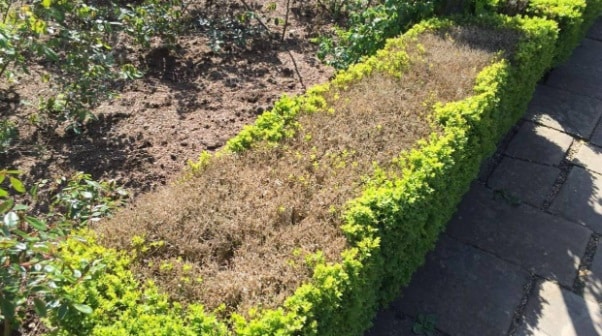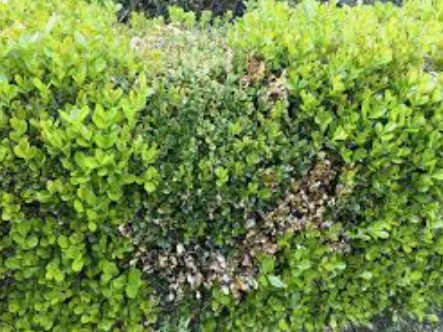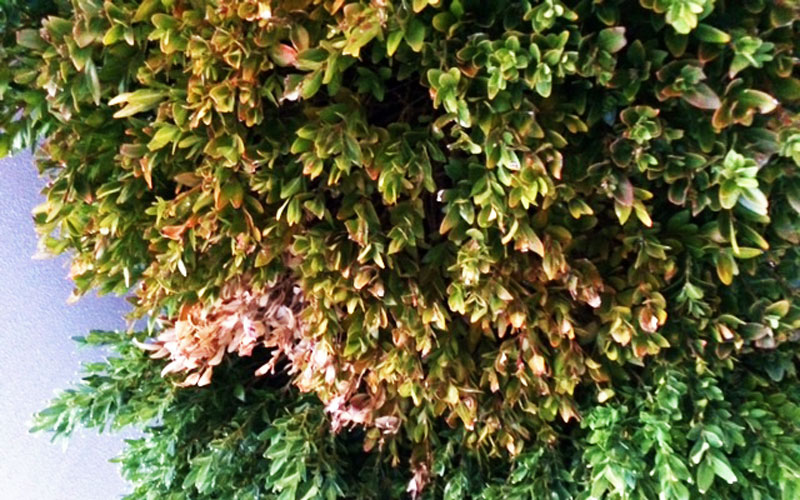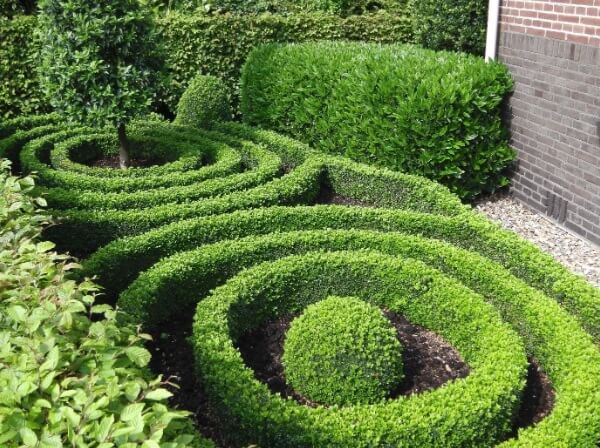Box Hedge White Fungus
True to its name this fungus covers plant leaves and stems with what looks like powdered sugar. On plant Buxus sempervirens.

Pin On Le Jardin Art Topiaire Espalier Et Les Haies
Even if you dont have honey fungus - getting nearly 100 years worth of life from a hedge is pretty darn good in my opinion.

Box hedge white fungus. It has become common in the UK Europe and in New Zealand. Boxwood blight is caused by the fungal pathogen Calonectria pseudonaviculata synonym Cylindrocladium pseudonaviculatum which causes leaf spots stem cankers defoliation and death of boxwoods. Life Cycle Symptoms Treatment and Prevention I see white stuff on plant leaves or stems.
The hedge is 6 yrs old but this has happened the last 2 summers. Unlike dust however simply wiping off the substance is not enough to help an affected plant. Prune a hedge with a convex top rather than flat and prune.
Buxus blight causes dieback and browning off of leaves of boxwood which drop off. The honey fungus had a musty decaying smell and we could take a sample to be analysed at a testing laboratory. These boxwood shrub pests feed on the underside of the leaves leaving them stippled with tiny white or yellow spots.
At the first sign blast the hedge with a jet of water to wash off the sooty mould and also the sap suckers. Put down new mulch to prevent spores from splashing up from the soil and apply fungicide. Stems become bare and sometimes with dark streaks.
Both European and American boxwoods are susceptible to boxwood mites. Learn more about what powdery mildew is how it develops and what you can do to prevent it. Treat with a seaweed solution.
My box hedge has a white powdery fungal infection. Ensure plants are well fertilised and watered. The disease is caused by two genetic types of fungi Cylindrocladium buxicola and Volutella buxi that attack the leaves and stems of the plant.
Is it powdery mildew. What are the symptoms. Box Blight Cylindrocladium buxicola is widespread throughout the UK and as it is an airborne disease there is no guaranteed means of prevention however there are measures which significantly reduce the possibility of severe infection.
Cut away and dispose of affected branches and leaves. It appears that privet is the shrub in question and it has been used for years in creating hedges. The main hedge is green no brown dead leaves.
It also forms cankers on the wood and in wet conditions white fungus all over. To help identify the disease place a few leaves in a plastic bag with. Powdery mildew is a fungal disease.
Decline is most often caused by the fungal disease Volutella. Its effects appear ahead of new growth in the spring when leaves on the tips of infected branches turn red then bronze. Boxwood blight Blight turns leaves spotty and brown and may cause them to drop.
Other plants that are related to boxwoods may also be hosts such as pachysandra and sweet box Sarcococca species. It usually appears in winter on plant leaves and flowers. A fine whitish mottling on the foliage of box plants can be caused by the box red spider mite Eurytetranychus buxi which is a mite that is specific to box.
Box blight is a disease of box leaves and stems caused by the fungus Cylindrocladium buxicola. Boxwood decline is common to both American and English box. This tiny creature feeds by sucking sap from the undersides of the leaves particularly during spring and early summer.
It is usually caused by a combination of diseases brought on by poor drainage excessive mulch soil compaction and occasionally weather. As the spots spread the leaves and stems become covered in a white puffy substance that causes the leaves to turn yellow and fall off. Buxus blight box blight is a disease caused by the fungus Cylindrocladium buxicola.
Signs of Disease A common shrub disease powdery mildew is a fungus that at first produces white spots on leaves. A treatment of pyrethrum or white oil may be required but addressing plant health will also be important. Entire leaves may be covered with the thin white layer of fungus which may be mistaken for dust.
White bush fungus is a very descriptive term and a pretty good guess for what ails your hedge. Eurytetranychus buxi is a spider mite the boxwood mite to be exact. In wet conditions the white spore masses of the fungus may be seen on the undersurfaces of infected leaves place leaves in a plastic bag with moist tissue for a few days to check.
Box blight is a disease which affects Boxwood Buxus sempervirens and its family of plants. Unfortunately that wasnt the end of the honey fungus - it is difficult to eradicate once it is in the soilair.

Dealing With Box Blight Box Hedge Blight Hopes Grove Nurseries

How To Cure Box Blight Once And For All Fantastic Gardeners Blog

Box Clever To Avoid Dreaded Blight

What To Do About Boxwood Blight Boxwood Garden Garden Pests Boxwood Plant

Boxwood Blight Disease Information About Treatment Of Boxwood Blight

How To Control Box Blight In Hedges

Buy Elegans Variegated Boxwood Buxus Sempervirens Elegantissima Free Shipping For Sale Online From Wilso Buxus Sempervirens Sempervirens Box Wood Shrub

How To Get Rid Of Buxus Blight Kings Plant Doctor

Dealing With Box Blight Box Hedge Blight Hopes Grove Nurseries

Is This The End Of Garden Box Herbidacious

Pin By Brandy Wall On Retsas Residence Landscaping Inspiration Front Landscaping Boxwood Hedge

How To Cure Box Blight Once And For All Fantastic Gardeners Blog

Buxus Dutch Box Hello Hello Plants Garden Supplies Garden Types Hedges Hedging Plants

Identifying Common Boxwood Pests Tips For Treating Bugs On Boxwoods





Post a Comment for "Box Hedge White Fungus"